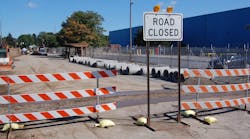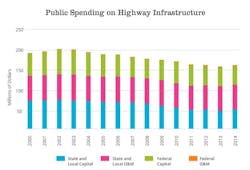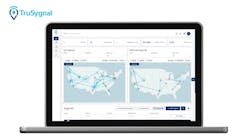If the nation’s infrastructure were a student in school, it would most likely be held back, based on the second consecutive D+ grade it received Thursday from the American Society of Civil Engineers.
The 2017 Infrastructure Report Card notes “incremental progress” toward improvement, however, since the last grade in 2013. The report gives America’s roads a flat D.
The D grade denotes “poor, at risk,” according to the report, meaning the infrastructure is in poor to fair condition and mostly below standard, with many elements approaching the end of their service life. A large portion of the system exhibits “significant deterioration,” while condition and capacity are of “serious concern with strong risk of failure.”
The report comes as the Trump administration looks for ways to make good on a campaign promise to rebuild Americas infrastructure with a trillion-dollar public-private funding program.
“We need our elected leaders – those who pledged to rebuild our infrastructure while on the campaign trail – to follow through on those promises with investment and innovative solutions that will ensure our infrastructure is built for the future,’’ said Norma Jean Mattei, ASCE president.
Highway funding has long been a top priority for the American Trucking Assns.
“Today’s release of the ASCE Report Card is just another sign of how desperately our country needs to move forward on a plan to rebuild and improve our infrastructure," said ATA spokesman Sean McNally. "Having a score of D+ for all our infrastructure — not to mention a D for our roads and a C+ for our bridges — should be a catalyst for stakeholders, for Congress and the Administration to come together on the kind of bill we need to make serious improvements.”
The American Association of State Highway and Transportation Officials (AASHTO) sees the Report Card as evidence that underinvesting in transportation infrastructure is failing America, calling it “yet another example of what occurs when a nation underinvests in the critical infrastructure systems that support economic development and quality of life.”
“The FAST Act, signed into law in 2015, provided a modest increase in federal investment over five years, but it did not solve the long-term funding issues that threaten the future of America’s highway, transit and passenger rail programs,” said AASHTO Executive Director Bud Wright. “The call for greater infrastructure investment began on the campaign trail and it continues in Washington today. It’s our hope that this report card will help turn that talk into action, prompting lawmakers to pass new legislation to provide long-term sustainable funding for America’s highway and transit programs.”
Three categories – Parks, Solid Waste, and Transit – received a decline in grade this year, while seven – Hazardous Waste, Inland Waterways, Levees, Ports, Rail, Schools, and Wastewater – saw slight improvements. Six categories’ grades remain unchanged from 2013 – Aviation, Bridges, Dams, Drinking Water, Energy, and Roads.
As for roads, ASCE points out that the system is “crowded, frequently in poor condition, chronically underfunded, and is becoming more dangerous.” Specifically, more than two out of every five miles of America’s urban interstates are congested and traffic delays cost the country $160 billion in wasted time and fuel in 2014.
The report also points to an $836 trillion backlog of highway and bridge needs.
The recommendations include:
- Increase funding from all levels of government and the private sector to tackle the massive backlog of highway needs.
- Fix the federal Highway Trust Fund by raising the federal motor fuels tax. To ensure long-term, sustainable funding for the federal surface transportation program, the current user fee of 18.4 cents per gallon on gasoline and 24.4 cents per gallon on diesel should be raised and tied to inflation to restore its purchasing power, fill the funding deficit, and ensure reliable funding for the future.
- Tackle congestion through policies and technologies that maximize the capacity of the existing road network and create an integrated, multimodal transportation system.
- Prioritize maintenance and the state of good repair to maximize the lifespan of roads.
- State and local governments should ensure their funding mechanisms (motor fuel taxes or other) are sufficient to fund their needed investment.
- All levels of government need to think long-term about how to fund their roads and consider potential alternatives to the motor fuel taxes, including further study and piloting of mileage-based user fees.
- Increase investment and expand the federal Highway Safety Improvement Program to find new ways and further propagate existing methods to make roads safe for all users.




